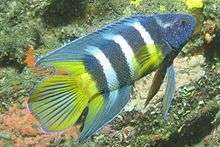Paraplesiops bleekeri
Paraplesiops bleekeri, commonly known as the eastern blue devil, blue-tipped long-fin or Bleeker's blue devil fish, is a species of fish in the family Plesiopidae. This colourful, secretive fish is endemic to Australia, where it is a protected species.
| Paraplesiops bleekeri | |
|---|---|
 | |
| Scientific classification | |
| Kingdom: | Animalia |
| Phylum: | Chordata |
| Class: | Actinopterygii |
| Family: | Plesiopidae |
| Genus: | Paraplesiops |
| Species: | P. bleekeri |
| Binomial name | |
| Paraplesiops bleekeri | |
| Synonyms | |
|
Plesiops bleekeri Günther, 1861[3] | |
Description
This species grows to 40 cm, and is recognizable by blue and white bands on the body, blue spots on the head, and blue dorsal and anal fins[4]. It also has a yellow base, pectoral, and caudal fins. The pelvic, posterior dorsal, and anal fins are all elongated.[5][6]
This species is a close relative of the southern blue devil (Paraplesiops meleagris), which lives in the colder southern Australian waters.[1]
Distribution
The fish is found in coastal waters of eastern Australia between the Gold Coast of southern Queensland and Montague Island,[1] most commonly between Sydney and Ulladulla.[5]
Behaviour
This species is shy and secretive. Males have appeared to defend territories in caves or overhangs, where it remains to attract females and drive males away.[5] They are most active at night.
Habitat
Paraplesiops bleekeri are benthic coastal reef inhabitants[4]. They live inside caves, under ledges and overhangs in reefs and estuaries[4]. The Devil in the Deep: Expanding the Known Habitat of a Rare and Protected Fish |journal=European Journal of Ecology |date=28 August 2018 |volume=4 |issue=1 |pages=22–29 |doi=https://doi.org/10.2478/eje-2018-0003}}</ref>. They were considered to inhabit waters ranging from 3 to 30 metres in depth[1][5], and are most often encountered in shallow waters less than 20 metres, however, recent observations suggest they also inhabit offshore reefs down to at least 50 metres[4].
Diet
This fish is known to eat brittle stars.
Conservation status
This species is protected under the laws of New South Wales Fisheries, in particular, the Fisheries Management Act 1994[4]. It is illegal to collect or possess them without a permit.[1][5]
They are protected because of their low abundance, and their desirability in the marine aquarium industry[4].
Efforts to protect them have included the conservation and protection of benthic estuarine habitats, as well as rocky offshore reef areas where they breed. Some protected habitats are:
- Solitary Islands Marine Park
- Port Stephens – Great Lakes Marine Park
- Jervis Bay Marine Park
- Long Reef Aquatic Reserve
- Bushrangers Bay Aquatic Reserve[6]
Name
The specific name honours the Dutch ichthyologist and physician Pieter Bleeker (1819-1878) who named two congeners of this species.[7]
References
- Eastern Blue Devil, Paraplesiops bleekeri (Günther, 1861) – Australian Museum
- Paraplesiops bleekeri, Eastern blue devil : aquarium
- WoRMS – World Register of Marine Species – Paraplesiops bleekeri (Günther, 1861)
- Fetterplace, Lachlan C.; Turnbull, John W.; Knott, Nathan A.; Hardy, Natasha A. (28 August 2018). "Natural History Report. The Devil in the Deep: Expanding the Known Habitat of a Rare and Protected Fish". European Journal of Ecology. 4 (1): 22–29. doi:10.2478/eje-2018-0003.
- Eastern Blue Devil Fish Paraplesiops bleekeri
- http://www.dpi.nsw.gov.au/__data/assets/pdf_file/0005/77396/Eastern-blue-devil-fish-Primefact-165---final.pdf
- Christopher Scharpf & Kenneth J. Lazara (29 March 2018). "Subseries OVALENTARIA: Incertae sedis". The ETYFish Project Fish Name Etymology Database. Christopher Scharpf and Kenneth J. Lazara. Retrieved 29 September 2018.
Further reading
- Eschmeyer, William N., ed. 1998. Catalog of Fishes. Special Publication of the Center for Biodiversity Research and Information, no. 1, vol. 1–3. California Academy of Sciences. San Francisco, California. 2905. ISBN 0-940228-47-5.
- Fetterplace, LC.; Turnbull, JW.; Knott, NA.; Hardy, NA. (2018). "The Devil in the Deep: Expanding the Known Habitat of a Rare and Protected Fish". European Journal of Ecology. 4 (1): 22–29. https://doi.org/10.2478/eje-2018-0003
- Fenner, Robert M.: The Conscientious Marine Aquarist. Neptune City, New Jersey: T.F.H. Publications, 2001.
- Helfman, G., B. Collette y D. Facey: The diversity of fishes. Blackwell Science, Malden, Massachusetts, 1997.
- Hoese, D.F. 1986: . A M.M. Smith y P.C. Heemstra (eds.) Smiths' sea fishes. Springer-Verlag, Berlin.
- Hoese, D. F. and R. H. Kuiter 1984. "A revision of the Australian plesiopid fish genus Paraplesiops, with notes on other Australian genera"; Records of the Australian Museum v. 36: 7–18.
- Maugé, L.A. 1986. A J. Daget, J.-P. Gosse and D.F.E. Thys van den Audenaerde (eds.) Check-list of the freshwater fishes of Africa (CLOFFA). ISNB Brussels; MRAC, Tervuren; and ORSTOM, Paris. Vol. 2.
- Moyle, P. y J. Cech.: Fishes: An Introduction to Ichthyology, 4th edition, Upper Saddle River, New Jersey: Prentice-Hall, 2000.
- Nelson, J.: Fishes of the World, 3rd edition. New York City: John Wiley and Sons, 1994.
- Paxton, J.R., D.F. Hoese, G.R. Allen and J.E. Hanley 1989: "Pisces. Petromyzontidae to Carangidae", Zoological Catalogue of Australia, Vol. 7. Australian Government Publishing Service, Canberra, 665 pp.
- Wheeler, A.: The World Encyclopedia of Fishes, 2nd edition, London: Macdonald, 1985.